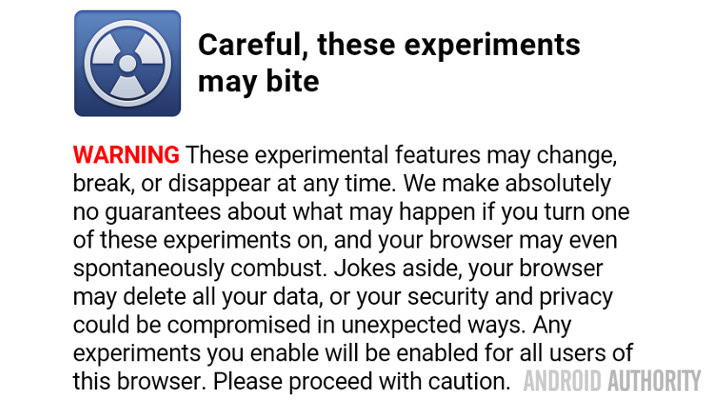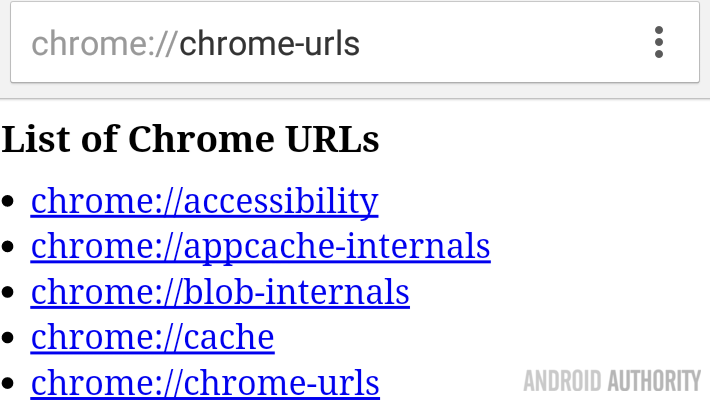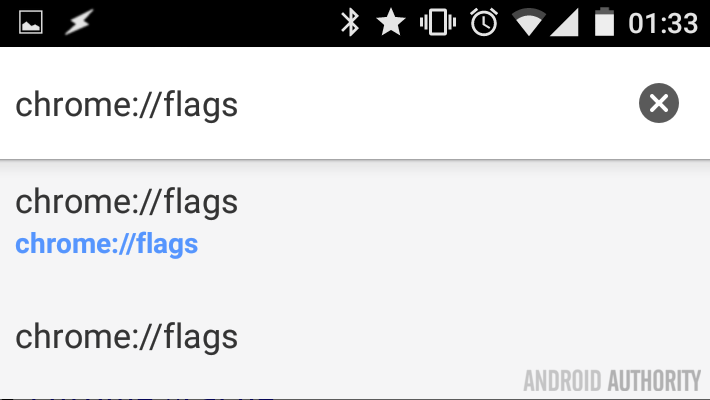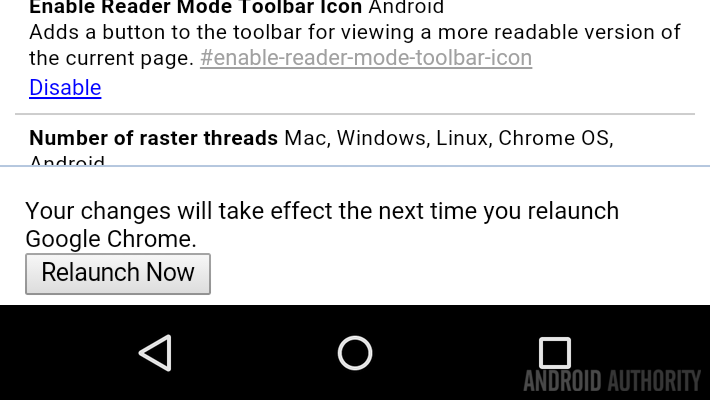Affiliate links on Android Authority may earn us a commission. Learn more.
Customize your mobile web experience using Chrome flags - Android customization
Published onMay 14, 2015
Have you been having fun tracking all of your movements through your Google Location history, as we walked through in last week’s Android customization post? We hope so. Now it is time to take to our web browser to make some subtle and significant tweaks, this week we will take an in-depth look at Chrome Flags.
We know that not all of you use Google’s Chrome web browser as your browser of choice for your Android device. However, Chrome is the default browser on many devices out there, so we thought we would take a minute to make sure you are getting the most out of it.
Before we get started

What are Chrome Flags?
Starting at the beginning, I will explain Chrome Flags as a set of very advanced and experimental settings for your Chrome browser. Hidden away in this extensive list of options will be the ability to turn on and off hardware graphics acceleration, touchscreen support and more, all the way down to fine tune control on form auto-fill tools and even disabling the new Bookmark Manager on your PC, if you don’t care for it.

Warning: I will shorten what Google has at the top of the flags page – do not rely on these flags, they are experimental and can crash your browser. Luckily, on Android, if we screw up really bad and crash Chrome by messing with these flags, we simply Clear Data on the app and we are good to go again. Do be a little bit more careful if you are messing around with Chrome on your PC, there is a reset button, but it is not as bulletproof as on Android.
Now it is time to get you into these fun settings, please go ahead and open Chrome, head to the Omnibox (address bar), type in the following and hit enter:
If you haven’t noticed this already, Chrome has a few of these Easter eggs tucked into the browser. On your Android device, try out Chrome://version for a super detailed overview of your browser version. On your Android device or PC, try hitting chrome://chrome-urls to see the entire list of available browser pages.

What flags should I change?
Once you are in the full list of available Chrome flags, you may be a little overwhelmed at which you should turn on, or off. Truth is, if you do not have a specific problem to solve, or are not exactly adventurous with your device, you probably shouldn’t be here. That being said, here is a quick list of some of the more popular flags to change.

Quick Note: Each Flag has been assigned an HTML anchor to make it easier to navigate to, as such, all you need to do is add the reference to each in the address, so it looks like chrome://flags/#Flag-Name. I’ve added the anchor as a link for each Flag below, but they are not typically formed URLs, so you can’t just click on them, instead, right click and choose Copy link address, then paste that in a new tab, just remember they only work in Chrome.
- FPS Counter – For the gamer in all of us, although a web page doesn’t exactly depend on a FPS count like a game might, it is still fun to see sometimes. #show-fps-counter
- Show Autofill predictions – Disabled by default, this flag will insert predicted text into text boxes for you. Not just for password anymore. #show-autofill-type-predictions
- Enable password generation – Sometimes choosing your own password is just too hard, let Chrome choose one for you. #enable-password-generation
- Maximum tiles for interest area – We talked about this in the past, basically, this is a way to control your RAM usage for Chrome. Check out the story to find out what you need to do. #max-tiles-for-interest-area
- Enable offline auto-reload mode – Turn this off to prevent tabs from automatically reloading if the previously failed to load. Perhaps you were offline at the time. Requires you to manually reload the pages. #enable-offline-auto-reload
- Disable click delay – Did you know that Chrome waits almost half a second sometimes before acting on your button clicks? That’s right, it delays so that you can trigger a double click action. If you never double click in your browser, go ahead and turn this guy on to speed up the click action. #disable-click-delay
- Disable the pull-to-refresh effect – Most people were excited to see pull-to-refresh in Chrome, if you were not, simply hit this to turn it off again. #disable-pull-to-refresh-effect
- Enable Enhanced Bookmarks – Rather, disable this one to turn off Google’s new bookmark manager. I mean, you might like the new tool, but those of us that dislike it, dislike it with a passion. #enhanced-bookmarks-experiment
- Password and account settings. Truth is, there are a few flags that deal with passwords, credential managers and related that might be fun to play with, however, as there is no guarantee that these flags will not expose all of your passwords to the internet, I will not recommend any of them. Please take precautions.
There are many more flags that may appeal to you, and you may decide to enable/disable them in different configurations on your Android device as compared to the setup on your PC. I totally encourage you to play with them to fine tune your user experience.
What’s next
You will have noticed that each flag in Chrome displays the available platforms for which it will operate. Most flags work almost everywhere, Mac, Windows, Linux, Chrome OS and Android, others may only work on one platform.
There are many flags that are designed to assist developers, such as the flag that makes it so a popup banner shows each and every time a page loads. Annoying for the rest of us, but required for testing.

Finally, many of the chrome://flags will require a browser restart before they will take effect. When this is true, a simple restart button pops up at the bottom of the screen. Choose all of your flags, hit the reset button and off you go with your new settings.
Next week
I wish we had more time to talk about more flags in Chrome for our Android customization post this week, we hope we pointed you toward a few good ones at least. Next week, let’s look at a really easy one, for the beginners in the crowd, let’s find out how to disable auto-correct on your Android device.
What are your favorite Chrome flags to enable or disable?